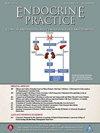Assessing Clinician Engagement With a Passive Clinical Decision Support System for Liver Fibrosis Risk Stratification in a Weight Management Clinic
IF 3.7
3区 医学
Q2 ENDOCRINOLOGY & METABOLISM
引用次数: 0
Abstract
Objective
Metabolic dysfunction-associated steatotic liver disease is common in obesity. Guidelines recommend liver fibrosis risk stratification with tools such as Fibrosis-4 (FIB-4) index, liver stiffness measurement with vibration-controlled transient elastography (VCTE) and/or hepatology referral for elevated FIB-4. Despite recommendations, implementation remains limited. Using mixed methods, we evaluated a 3-strategy implementation bundle to improve fibrosis risk stratification—a FIB-4-based electronic health record embedded clinical decision support system (CDSS), educational outreach, and internal facilitation in a weight management clinic.
Methods
The primary outcome was penetration: the proportion of patients with elevated FIB-4 completing VCTE or hepatology referral. We compared rates, pre and postactivation of implementation bundle using Fischer’s exact test. Semi-structured provider interviews, guided by the i-PARIHS framework, assessed acceptability and feasibility 3 months postimplementation.
Results
In the preactivation phase, 880 out of 3933 (22.4%) weight management visits had the necessary labs to calculate automated FIB-4 scores with 128 elevated scores. In the postactivation phase, 2513 of 4634 weight management visits (54.2%) had automated FIB-4 scores; with 234 elevated score. Preactivation, there were no VCTE and 2 hepatology referrals. Postactivation, there were 3 VCTE referrals and 2 hepatology referrals (Fischer’s exact test P value = 1.00). Providers cited shared responsibility with primary care, low awareness and trust in risk-stratification tools, workflow challenges, and competing demands as barriers. Educational outreach and facilitation improved CDSS engagement, while technical issues reduced it.
Conclusion
This implementation strategy bundle did not achieve meaningful metabolic dysfunction-associated steatotic liver disease fibrosis risk stratification. Electronic health record-based CDSS shows promise but requires alignment with provider priorities, seamless workflow integration, and robust technical infrastructure.
评估临床医生参与被动临床决策支持系统肝纤维化风险分层在体重管理诊所。
目的:代谢功能障碍相关的脂肪变性肝病(MASLD)在肥胖症中很常见。指南建议使用纤维化-4 (FIB-4)指数、振动控制瞬时弹性成像(VCTE)测量肝脏硬度和/或FIB-4升高的肝病学转诊等工具进行肝纤维化风险分层。尽管提出了建议,但执行情况仍然有限。使用混合方法,我们评估了改善纤维化风险分层的三种策略实施组合-基于fib -4的电子健康记录嵌入式临床决策支持系统(CDSS),教育推广和体重管理诊所的内部促进。方法:主要终点是穿透:FIB-4升高的患者完成VCTE或肝病转诊的比例。我们使用Fischer的精确测试比较了执行包激活前和激活后的比率。半结构化的供应商访谈,在i-PARIHS框架的指导下,在实施后三个月评估可接受性和可行性。结果:在激活前阶段,880/3933(22.4%)体重管理就诊患者有必要的实验室来自动计算FIB-4评分,其中128分升高。在激活后阶段,2513/ 4634例体重管理就诊(54.2%)有自动FIB-4评分;以234分的高分。激活前,没有VCTE和2例肝病转诊。激活后,有3例VCTE转诊和2例肝病转诊(Fischer精确检验p值=1.00)。供应商列举了与初级保健的共同责任、对风险分层工具的认识和信任度低、工作流程挑战和竞争需求等障碍。教育推广和促进提高了CDSS的参与度,而技术问题则降低了参与度。结论:该实施策略并未实现有意义的MASLD纤维化风险分层。基于EHR的CDSS显示了前景,但需要与供应商优先级保持一致,无缝的工作流集成和健壮的技术基础设施。
本文章由计算机程序翻译,如有差异,请以英文原文为准。
求助全文
约1分钟内获得全文
求助全文
来源期刊

Endocrine Practice
ENDOCRINOLOGY & METABOLISM-
CiteScore
7.60
自引率
2.40%
发文量
546
审稿时长
41 days
期刊介绍:
Endocrine Practice (ISSN: 1530-891X), a peer-reviewed journal published twelve times a year, is the official journal of the American Association of Clinical Endocrinologists (AACE). The primary mission of Endocrine Practice is to enhance the health care of patients with endocrine diseases through continuing education of practicing endocrinologists.
 求助内容:
求助内容: 应助结果提醒方式:
应助结果提醒方式:


